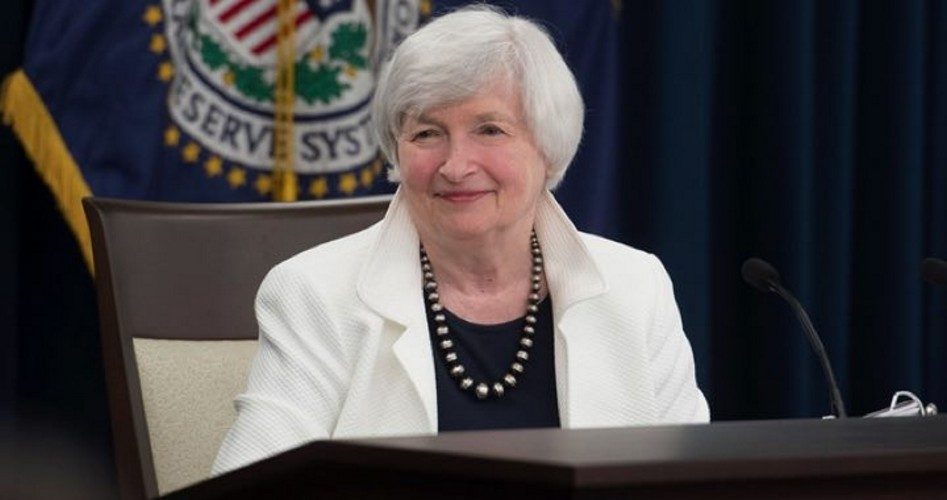
“My colleagues and I may have misjudged the strength of the labor market, the degree to which longer-run inflation expectations are consistent with our inflation objective or even the fundamental forces driving inflation,” Federal Reserve Chairman Janet Yellen (shown) told the annual conference of the National Association for Business Economics in Cleveland on Tuesday.
Yellen said she was puzzled as to why inflation has remained chronically below the Fed’s inflation target of two percent annually.
That the Federal Reserve has the power to even attempt such management of the entire U.S. economy should be concerning in itself. But a closer examination of Yellen’s remarks, both to the business economists in Cleveland, and to the conference of other central bankers last month in Wyoming, indicates that whatever actions she takes, will most likely be in coordination with globalist bankers in other countries.
At Jackson Hole, Wyoming, in August, Yellen and other central bankers addressed several concerns they have about the world economy. The theme of the conference was “Fostering a Dynamic Global Economy,” and the participants addressed the slow recovery from the Great Recession of 2008-2009. This slow recovery has led to discontent in several countries, leading to the election of Donald Trump in the United States, and the decision of a majority of the British to leave the European Union.
This no doubt concerns the global elites, of which the Federal Reserve, headed by Yellen, and other nations’ central banks are an integral part of their control over the world’s economy. When the Federal Reserve was created by an act of Congress in 1913, advocates were extremely careful not to call it a central bank because there was so much opposition to having such a bank.
While the chairman of the Federal Reserve System is appointed by the president, the Fed itself is a private institution, owned by its member banks.
Yellen, whose four-year term ends early next year, made several remarks to the two groups that can be questioned. For example, she said that if the Fed moved too slowly in raising interest rates, it could lead to an overheated economy (by which she means an inflation-driven boom that inevitably collapses at some point). She also stated that inflation can be affected by temporary factors, such as a price war among mobile phone companies, and tight labor markets.
The reality is that Yellen is confusing inflation with a rise in prices. Saying that rising wages and prices causes inflation is somewhat like saying that wet streets cause rain. Inflation is an increase in the supply of money and credit, and higher prices and higher wages are often a result of inflation, not the other way around.
Since the creation of the Federal Reserve System, the entity most responsible for an increase (inflation) (or a decrease, for that matter) in the amount of money in circulation is the Federal Reserve, which Yellen heads. They do this in various ways, and Yellen touched on one way. She said the Fed would be “looking at inflation very carefully” to determine interest rate hikes. The interest rate hikes she is referencing are those that the Fed charges member banks.
If the Fed lowers that rate (known as the discount rate), then banks will borrow more from the Fed, thus putting more money into circulation. This will generally cause prices to be higher than they otherwise would be, but they are a result of the Fed’s inflation, not the cause.
It is the assertion of many Fed-supporting economists and politicians that such inflation causes economic growth. Actually, without the actions of the Fed, prices tend to fall (as they did in the last quarter of the 19th century), resulting in greater wealth for consumers. Rather than causing economic growth, Fed-driven inflation ordinarily keeps prices from falling, making it increasingly difficult for the average American to build wealth. Anticipating that prices are going to continue to spiral upward, most individuals will spend rather than save, thinking there is little point in saving, if their money will be worth less in the future.
Increasing the supply of money is the very definition of inflation. If the supply of money and credit is increased, then the value of money will drop, which means that it will take more money (which is now of less value than before) to buy the same amount of goods.
Tremendous economic growth can hide inflation — for a time. For example, during the 1920s, Fed actions caused the money supply to increase a staggering 62 percent! Prices, however, remained relatively stable during most of the decade because of the great increases in production brought on by the freer economy of the time. Without the Fed pumping so much money into the economy in the 1920s, prices would have fallen, allowing an even wider distribution of the nation’s wealth. For example, a product offered for sale at $100 would have been more likely to be offered at $70. This would have left $30 more in the consumer’s pocket to either buy something else, or to save (keeping interest rates lower in a more natural, free-market way).
Supposedly created to tame the boom and bust cycle of previous times, the Fed was less than two decades old when the nation’s economy collapsed in 1929. Since that time, Fed-driven booms have led to predictable busts again and again, such as the easy credit housing boom that led to the great bust of 2008.
Yet, Yellen claims to be perplexed. Perhaps she and her fellow Fed directors should look into the mirror, and perhaps it is time for Congress to end the Fed, and let the free market determine prices.
Photo of Janet Yellen: Federal Reserve



